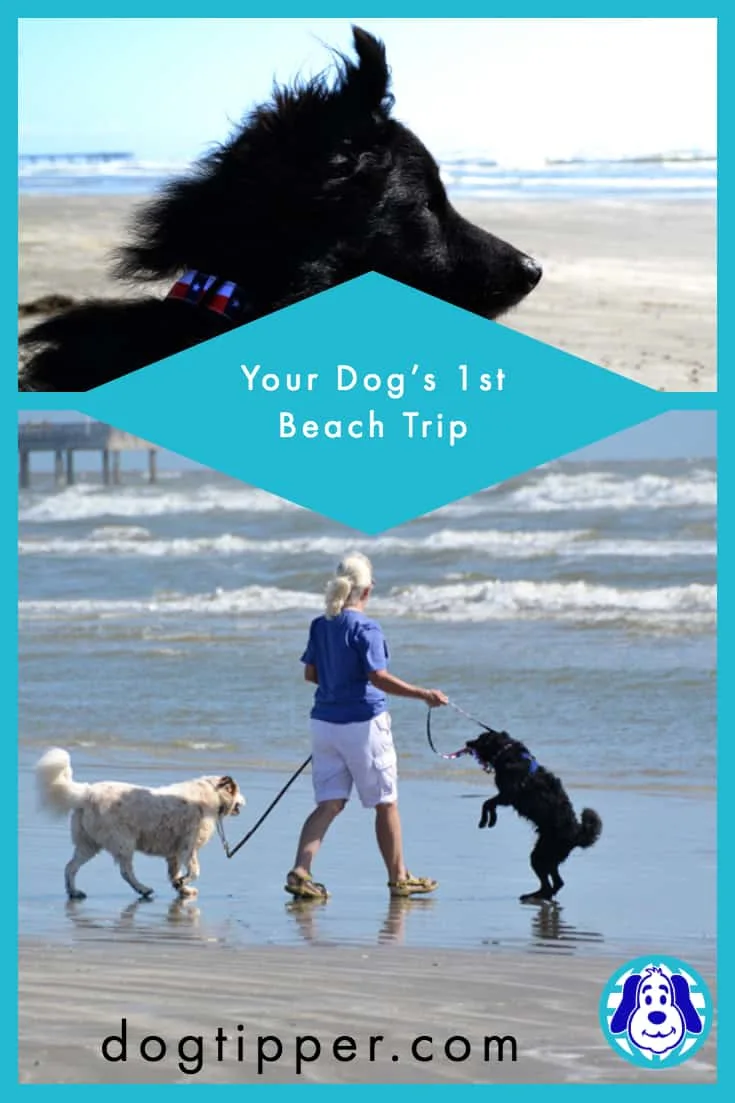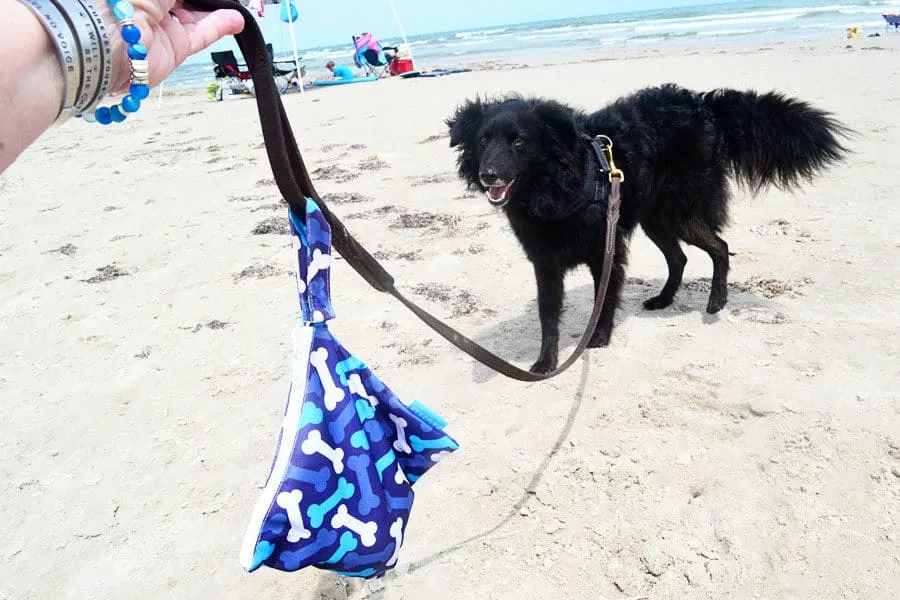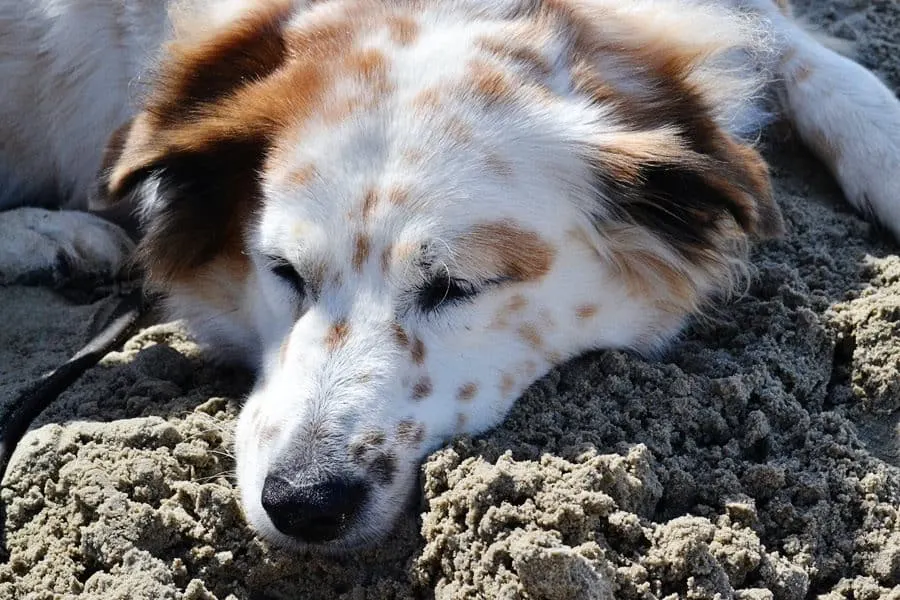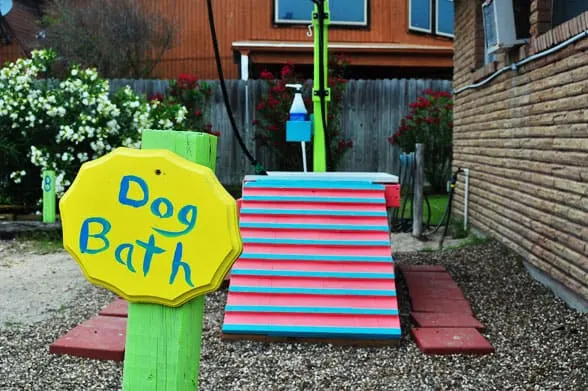Sun, sand, surf—and Spot: all the ingredients for a great summer getaway! Your dog’s first beach vacation is a time that you’ll remember for years–but it’s important to make sure you locate dog friendly beaches and take a few extra steps to keep your dog safe.
Whether your dog is still a puppy or a seasoned traveler, taking your dog to a dog friendly beach for the first time is a time when you can enjoy the beach through new eyes, and your dog can experience all the new sights, sounds and smells of the ocean.

First, though, you want to make sure that you set your dog up for success by planning a trip that you’ll both love. I remember Irie and Tiki’s first visit to the beach; we headed to Port Aransas, Texas. Although we’d traveled locally with them, this was their first time to play in the surf and dig to their heart’s content in the sand. Barli’s first beach visit was to Magnolia Beach where he proved himself to be quite the beach dog!
What’s the secret to a successful beach trip with your dog? Like any good vacation, it starts with good planning—and packing.
Before Your Trip
The fun of a beach getaway starts before you grab the leash and the car keys—it begins with your pre-trip planning. When we travel with our dogs, we plan more than we do for a traditional trip, making sure we’ve found a destination that will welcome us all with open paws.
Research dog-friendly beaches
We look for dog-friendly beaches. We’re lucky because most Texas beaches–other than some stretches manned by lifeguards–are dog-friendly year around and at all hours of the day. On some crowded beaches, especially on the East Coast, look for limited dog-friendly hours during peak summer season.
Do some checking before you book your getaway (a quick call to the destination’s parks department will usually fetch you the current regulations).
Should you visit a dog beach or a dog-friendly beach?
Know the difference between a dog beach and a dog-friendly beach.
If your destination has a designated dog beach (which usually means one that allows off-leash romping), ask yourself if that’s the best option for your dog. Dog beaches are a good fit for dogs who enjoy dog parks and all the social interaction that goes along with off-leash play.
Other dogs—including ours—are more comfortable at an on-leash dog-friendly beach, walking and playing at our side.
Prepare for safety
Our dogs are happy just playing in the surf; they don’t want to get out and swim—but if your dog is a swimmer, be sure to pack a dog life vest. Surf and riptides can quickly tire even the best swimmers.

Pack for success
We all know that a trip to the beach means plenty of special supplies, from beach chairs to sunscreen—and that applies to four-legged travelers, too. Our beach packing list for includes:
- dog shampoo
- old towels
- extra dog waste bags
- our YUCKY PUPPY poop bag carrier set (one for containing that used bag of poop until we find a trash can, another for wet collars and leashes)
- a beach umbrella for shade
- GPS tracker for each dog
- a large water bowl (we use a silicone cake pan)
- liter bottles to fill with fresh water (we freeze one)
- spare collars not only so we’ll have one in case of breakage but also to give the dogs a dry collar after a day in the salt water
- a spare fixed leash
- a retractable leash. Barli likes to romp in the shallow water and, in the shallow water of our favorite beaches, we don’t have to worry about underwater hazards snagging the leash.
During Your Beach Visit

Hooray—it’s time for your dog’s beach vacation! It’s time to make some memories—but make sure those memories are good ones by heeding a few precautions.
Tag your dog
It may be hard to get your dog’s attention at the beach. Even the best trained dogs will be distracted by the fun, the activity on the beach, plus all the new sights and smells—and the surf may drown out your voice.
Be sure your dog’s collar includes at least one ID tag with your name and cell phone number. (If you’ll be staying at the beach for a week or so, consider adding a temporary tag with your local address, too.)
Also, be sure your dog is microchipped, that you carry that microchip with you in case your dog is lost and you have to call local shelters and you’ve updated the registration on the microchip.
Don’t let your dog drink salt water
Along with lapping up the fun of romping in the waves, most dogs will also want to lap up some salt water—a recipe for diarrhea and other potential problems.
The best way to keep your dog from drinking sea water (which must be a canine cocktail of salt and fish-tinged water) is to hydrate your dog before he steps into the surf.
We carry a water bowl to the beach and a collapsible water bowl on beach walks—and our dogs are encouraged to drink before every visit to the water.
If you’re staying at a hotel with a freezer, you can also freeze plastic liter bottles (leave them 1/3 empty so they don’t burst) to provide cool dog water throughout the day.

Follow the rules
OK, we’ve all seen those people that walk right past the sign specifying that dogs must be on leash at all times—then turn their dogs loose.
Don’t be that person–follow proper beach etiquette with your dog at all times.
Even a few incidents and complaints can mean a dog-friendly beach one season becomes an off-limits beach the next summer. If your beach destination requires a leash, it may be due to crowds, wildlife, or dangers like car traffic on the beach, situations where leashes keep your dog and everyone else safe.
And always, always pick up after your dog.
Watch for litter
Another good reason to keep your dog on leash at the beach is to keep him out of any litter that may have washed up on the sand.
More than just discarded soda cans, beach litter can span everything from industrial waste to rotting fish. Sharp fishing hooks—and frightening tangled fishing line—are hazards both in and out of the water.

Watch out for jellyfish!
The beach itself makes the perfect place for a nice, long dog walk but you’ll need to keep an eye out for a few troublemakers including the Portuguese Man-Of-War jellyfish.
The tentacles of these iridescent purple creatures produce a nasty sting.

Don’t overdo it
All that fun makes a puppy tired! In your dog’s excitement, he might want to play and play, but make time for a good nap in the sand and plenty of down time.
After Your Beach Day

Rinse – and repeat!
After a day in the salt water and sand, be sure to rinse your dog in fresh water, even if you don’t have time for a complete dog bath.
Rinse off–then rest up for the next day’s fun in the sun!
- Review: Jimmy BX7 Pro Anti-Mite Vacuum Cleaner - December 16, 2024
- 🎉 GIVEAWAY: Lord of the Pets Portrait of Your Dog! - November 26, 2024
- Review: Lord of the Pets Portraits - November 17, 2024
